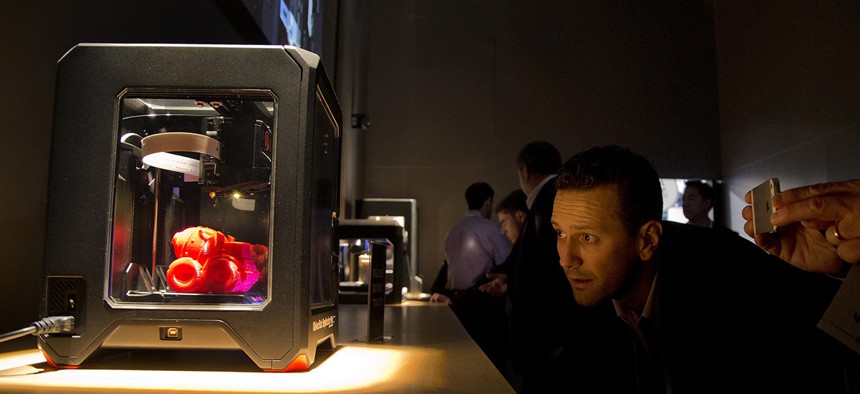Scientists Figured Out How to Steal Any 3-D-Printed Product Just From the Sounds the Printer Makes

Trade show attendees examine the MakerBot Replicator Mini 3D printer at the International Consumer Electronics Show, Wednesday, Jan. 8, 2014. Julie Jacobson/AP
If your company uses 3-D printing for anything confidential or sensitive, it might be time to invest in some soundproofing.
If your company uses 3-D printing for anything confidential or sensitive, it might be time to invest in some soundproofing.
Sometime in the future, everything is going to be 3-D printed at a moment’s notice. Need a new pair of glasses, a taco, or some painkillers? Just print them out and wait a little while.
At least, this is the future we’ve been promised for 3-D printers, although we’re not quite there yet. But today, 3-D printing has become a useful tool for rapidly prototyping new ideas at companies large and small, and new research suggests that it’s relatively simple to steal someone’s designs as they’re being printed. Scientists at the University of California, Irvine, have figured out that just by recording the whirrs of a 3-D printer, they can reverse-engineer the design for whatever it was creating.
Every printer makes a specific set of sounds as it prints out objects. A series of algorithms created by the team at Irvine allow those sounds to be converted into the shapes of those prints. As graduate researcher Sujit Chhetri suggested in the team’s video, a hacker could use a regular smartphone’s sound recording function, leave it recording until the printer is finished, and then run the sounds through their program.
The series of learning algorithms figure out the shape that the sounds are likely representing, as well as how fast the printer is moving, and whether there are multiple printer heads. As a test, the team printed out a key-shaped object. The team’s listening and reconstructing software produced a replica about 90 percent as accurate as the original.
The team said in the video that they wanted to highlight the potential risks of 3-D printing sensitive materials. Chhetri told Quartz that the team is working on improving the accuracy of their method, and suggested that someone with more nefarious intentions could potentially do something similar.
“The cost of designing the attack model is very low,” Chhetri said over email. “They can run their algorithms in any PC.”
Large companies, especially tech companies like Apple, already go to extreme measures to keep the products they’re working on a secret. Imagine if a janitor could leave their phone by a 3-D printer for an hour, and have the design of the next version of the iPhone sitting their pocket. We could be on the verge of a new era of corporate blackmail and espionage, where bad actors stash listening devices in company labs, print off their own prototypes, then demand payment or threaten to release the designs. It’s a brave new world out there.
NEXT STORY: Video: Virtual Reality Tech Brings Mars to Earth





